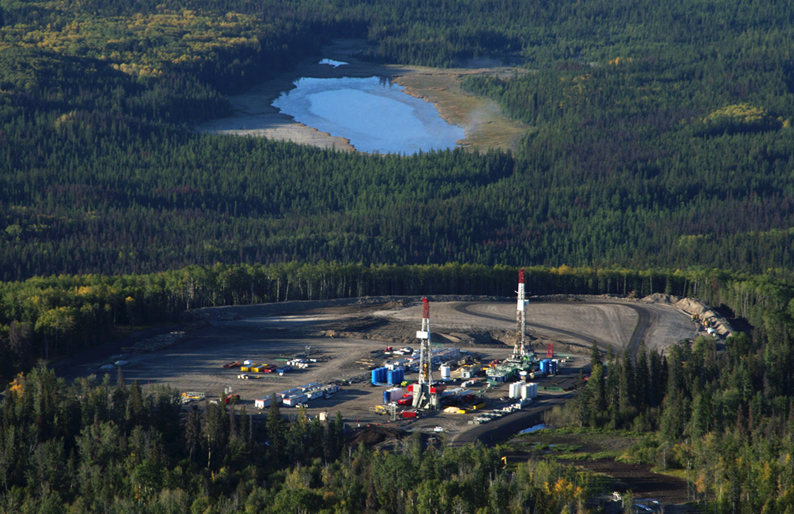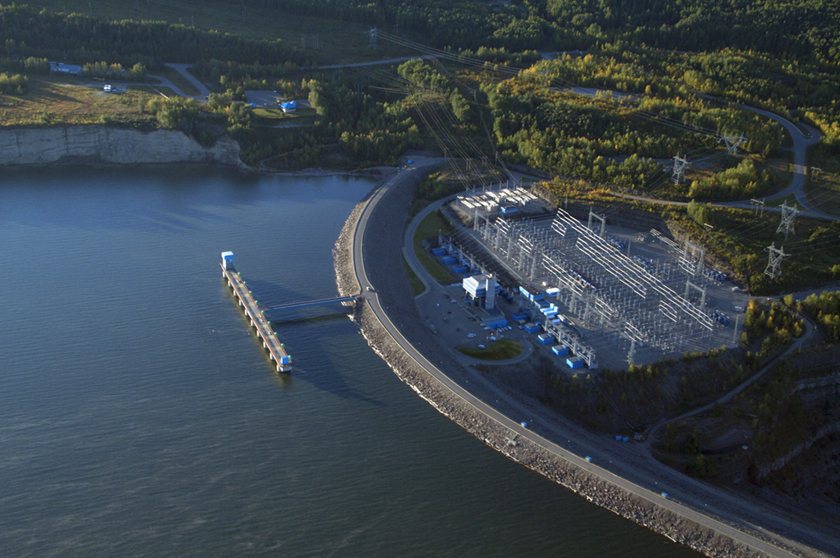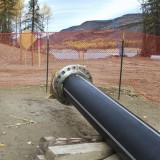Did BC Energy Minister Rich Coleman outright lie in the Legislature when he promised public consultation for a massive new pipeline to draw billions of litres of water from BC’s biggest hydroelectric dam, the Williston Reservoir, to supply the natural gas industry? A new documentary from Global TV leaves little doubt he did just that.
This past weekend, Global TV’s national investigative journal, 16×9, aired a 16 min story titled “Untested Science”, on the exploding natural gas hydraulic fracturing (or “fracking”) industry in Northeast BC and Alberta. I assisted with the film, contributing a significant amount of footage from a forthcoming feature documentary project I’m working on with another Vancouver filmmaker, Fiona Rayher.
For me, the most poignant aspect of the must-see story was its coverage of the enormous use and contamination of fresh water for these fracking operations, which blast a mixture of high-pressure water, sand and toxic chemicals deep underground to crack open shale formations, thus releasing gases trapped within. The practice has become highly controversial everywhere it’s practiced around the world – generating a ban in France and moratoria in places like Quebec and parts of the Northeast United States. Meanwhile, BC, a global hotbed for the industry, has largely escaped public and regulatory scrutiny – but that’s starting to change, as this 16×9 documentary demonstrates.
 The story clearly shows Minister Coleman, responding in the Legislature this past June to a question from Independent MLA Bob Simpson – who, along with fellow Independent MLA Vicki Huntington, has worked hard to put fracking under the microscope in Victoria – regarding the then-proposed water pipeline by fracking giant Talisman Energy and Canbriam Energy into the Williston Reservoir.
The story clearly shows Minister Coleman, responding in the Legislature this past June to a question from Independent MLA Bob Simpson – who, along with fellow Independent MLA Vicki Huntington, has worked hard to put fracking under the microscope in Victoria – regarding the then-proposed water pipeline by fracking giant Talisman Energy and Canbriam Energy into the Williston Reservoir.
Mr. Simpson asked whether the proposal by Talisman Energy and Cambrian Energy to remove 7.3 Billion litres of water a year from behind the dam has in fact already been approved, without public consultation. Here’s how Coleman replied:
“There will be an extensive process of public consultation, discussion and negotiations with First Nations before anything would go ahead.”
Two months later, the companies got their approval – in the form of 20 year water extraction licenses from the BC Government – absent any public consultation. The highlight of Global’s program is the bumbling response of Coleman to their questions about why he lied in the Legislature when he promised “an extensive process of public consultation.” Here’s part of Coleman’s feeble answer: “…And that could have been a mistake in language by me…I mean, basically what I was trying to say is that we would do government process with regards to water licenses.”
 By the time I was up in the Peace Valley in early October, the construction was already well underway, proceeding at a furious pace. I counted 3 different coupling machines at work, fusing together 50-60 foot lengths of black polyethylene pipe, approximately 10-12 inches in width – for two side-by-side pipelines.
By the time I was up in the Peace Valley in early October, the construction was already well underway, proceeding at a furious pace. I counted 3 different coupling machines at work, fusing together 50-60 foot lengths of black polyethylene pipe, approximately 10-12 inches in width – for two side-by-side pipelines.
A worker there described the process to me. The machine heats up one end of each pipe, then presses them together until they bond. Each machine can fuse a new length of pipe every half hour or so. With at least three machines running, the construction of the 37 mile pipeline from the edge of the reservoir to the companies’ nearby fracking leases was progressing rapidly.
I drove out to the end of the line, where the twin pipes will eventually plunge into the reservoir and begin hoovering out 10 million litres of water every day – mind you, before it gets turned into electricity for British Columbians by passing through the dam’s turbines (it’s of course also permanently removed from the Peace River’s downstream ecologies). While filming the work underway there, a silver truck from Talisman barreled up to me. The driver rolled down his window and began barking questions at me; as soon as he ascertained I didn’t work for the company he told me to “Take my pictures and fuck off.” He claimed it was private property, to which I replied that we’d have to agree to disagree on that point – in perfectly well-mannered, expletive-free speech (okay, maybe not quite). I finished my filming at a deliberately leisurely pace, packed up and left.
What I didn’t get into with this fellow from Talisman was the fact that my family’s ranch, Goldbar at 20 Mile, sits beneath that there reservoir. It was flooded years ago to provide the people of BC with affordable electricity – not for the fracking industry to get its water. And therein lies the problem with this whole scenario – or one of them, anyway.
 British Columbians are being told by Coleman and his government that we need to flood yet another section of the Peace River Valley for Site C Dam; and yet all of the power from that dam is destined not for BC households and small businesses, but to power the fracking industry and up to six new mines in the region (BC’s electrical demands are on a steep decline, to the point we’re currently abundantly self-sufficient in electricity).
British Columbians are being told by Coleman and his government that we need to flood yet another section of the Peace River Valley for Site C Dam; and yet all of the power from that dam is destined not for BC households and small businesses, but to power the fracking industry and up to six new mines in the region (BC’s electrical demands are on a steep decline, to the point we’re currently abundantly self-sufficient in electricity).
Meanwhile, we’re sucking unmade electricity – in the form of water – from an existing hydroelectric reservoir, to provide another vital resource for fracking. And all this electricity and water go to industry at a fraction of what it’s worth. We’re currently selling power to big industry for about half what you and I pay on our residential bills – and that gap is only set to widen.
So here is the question facing British Columbians, when it comes to the fracking industry and the matter of Site C Dam:
Do you support subsidizing the oil and gas and coal industries with endless amounts of fresh water – including taking it from our public hydroelectric dam – plus building a $10 Billion new dam, to be paid for by your tax dollars and much increased power bills, all so these industries can get their power for half to a third what you pay for it?
That’s the deal Energy Minster Rich Coleman and Premier Christy Clark would have you do. Just don’t expect them to ask you this question. They’ve made their position on public consultation abundantly clear.


It just doesn’t end with the lying, give aways, and pollution of our province. Take back our BC!
this fracking and water useage is terrible. What kind of payoffs is this provincial government getting for doing this.
As far as i’m concerned they are traitors to their oaths to their province, their country, their world, their creator, and themselves. It is totally disgusting.
David, only a fraction of private power in BC is wind (and it’s even less reliable or firm than RoR) – the majority being primarily spring freshet RoR, which is essentially useless to BC. We’re paying 2-4 x the market rate for this power and forced to dump it to our neighbours at a loss. The recent Hydro panel report determined we spent 49% of our electricity purchases on just 16% of our power for IPPs. BC trades power because it can, not because it needs to. Just because we run a tiny trade deficit the occasional year doesn’t mean we “DEPEND” on outside electricity. The Columbia downstream benefits alone would cancel this out in any year if we really needed the power. Moreover, here’s a telling passage from a recent article in the Whistler Pique – the only issue is the projections for domestic use here are still too high – we’re on track to use just over 50,000 GWh this year, same as last year, which suggests a comparable number for next year, not close 55,000: “Purchases of electricity from IPP’s actually supply BC Hydro with more power than it expects domestic customers will actually demand between 2012 and 2014. In each of these years it expects to generate 52,600 GWh through “heritage assets” – that means publicly-owned facilities such as the Revelstoke and WAC Bennett hydroelectric dams. Residential, commercial and industrial customers are expected to purchase 54,494 GWh of electricity in 2012. BC Hydro will have 62,814 GWh to provide in this year alone thanks to 10,114 GWh in IPP purchases.” So we’ll actually likely be over-stocked by over 12,000 GWh of power in 2012, thanks to these rip-off IPPs…But you’re taking us off topic here. We’ve dealt so much with IPP bullshit in these pages, I’m not delving any further into that matter in this comment thread – feel free to peruse our archives for more detailed and well-sourced critiques of IPPs. The story here is about the fracking industry, water from Williston and the lack of need for Site C…Your comments make you sound suspiciously like a private power booster and I advise you this is an IPP troll-free zone. Just be warned that further attempts to steer this conversation into IPP misinformation will result in the deletion of said comments.
Also Damien, in 2011, BC Hydro could only supply 75% of BC’s demand for power from its dams and gas fired generators.
The rest 25% BC Hydro had to buy from independents, or to import dirty American (read GE) coal fired power.
Damien you are wrong about the private power industry. BC Hydro buys only 25% of the snowmelt power in June, July and August. This allows BC Hydro to fill its dams higher during the summer (if not selling to California) and thus have more power in the winter.
And power from wind turbines is mostly in the winter, when it is needed most.
Well, it’s showing signs of leveling off this year, Hugh, but that’s after a significant tumble – on the order of 6% over the two previous years. Plus we have the Columbia Downstream benefits, increased conservation opportunities, and a doubling still of private river power coming on the market in the next year (though that itself offers little-to-no benefit to our energy mix, as we’ve often illustrated in these pages). You raise a very pertinent question: “Why would they be draining water out of the reservoir?” The fact is very little of this makes sense, unless you view it through the lens of public subsidies for industry. We don’t need Site C for our own purposes either, as I noted – this new dam is undoubtedly to furnish fracking operations, gas processing and LNG plants and coal mines with cheap power and water – and the public needs to be very clear about that. The people of BC should be able to decide for themselves whether they’re keen on massively subsidizing the oil and gas and coal industries with water and electrical resources.
Electricity usage in BC isn’t in steep decline, but it has leveled off. But demand is expected to grow, due to electric cars for example. For years they’ve been going on about needing more electricity, so why would they be draining water out of the reservoir. I thought BC Hydro needed it.
Thanks Jack. We’ve also seen reports of fracking-related seismic activity in Arkansas and Oklahoma – http://ecocentric.blogs.time.com/2011/11/08/did-fracking-help-cause-oklahoma-earthquakes/?xid=gonewsedit and recently in BC as well – http://www.calgaryherald.com/news/Controversial+fracking+linked+earthquakes/5481341/story.html
Also one should take into account the findings in the U.K. that Fracking causes earthquakes note Blackpool, U.K. Damien always enjoy your, to the point recording/reporting, keep up the good work. As for that bunch in Victoria, well lets hope the the citizens of B.C. choose to give them the boot in 2013 or before. Well done Bob Simpson and Vickie Huntington.
The actual exchange as recorded in “Hansard” for Wednesday, June 1, 2011, Afternoon Sitting [Page 7752]:
PUBLIC CONSULTATION ON WILLISTON RESERVOIR WATER DIVERSION
B. Simpson: That withdrawal is actually up on webpages. It is the worst-kept secret in the South Peace. The question from that region is: what is the public consultation process for a water withdrawal of that magnitude? Both First Nations and the general public would like to know, from whatever minister that’s appropriate for this: what is the process that the public can be engaged in, in the diversion and pipeline withdrawal of 7.3 billion litres per annum from the Williston reservoir behind the W.A.C. Bennett dam?
Hon. R. Coleman: … There will be an extensive process of public consultation, discussion and negotiations with First Nations before anything would go ahead.
I must commend you on bringing these very important issues to the publics attention. One thing I would like to add is that what is happeneing here in BC and with the Peace River water system is not only affecting BC but also Alberta and the NWT all the way to the Arctic Ocean. More people need to be made aware of this very damaging path that is being taken, as we are being told we need this by the lying, cheating, thieving gov’t this story is about!
Thanks for writing about this.
I watched the Global TV programme 16×9 and yes, Rich Coleman looked exactly how a liar acts. It was sooooo pathetic to see this huge, grossly overweight (read FAT) man squirm like a school kid caught out lying.
I also showed the contempt and arrogance that this man has for the legislature and all it stands for.
Rich Coleman does not deserve to represent his constituents – but the same can be said for the rest of the BC Liberal government.
I will quit while I’m ahead otherwise I will fill pages of negative personal comments about the BC Liberal MLA’s none of whom are worth the time spent on their abilities.
As Ignatieff said just prior to the last federal election – “Rise up – Rise up” – take BC back for the people of this province.
Thanks Damien, your comments and exposure is greatly appreciated.
Wow Damien, this is powerful stuff. Thank you for getting this info out. We need people like you and our courageous MLA’s Huntington and Simpson to get the truth out. We definitely can’t trust this bunch of Lieberals to tell us the truth. As Mr. Coleman has proved with this,he doesn’t know what truth is.